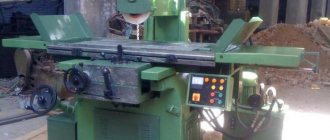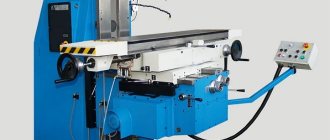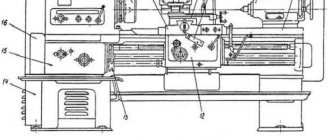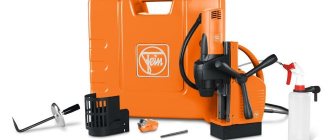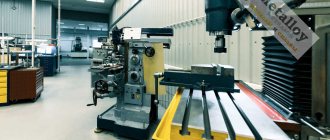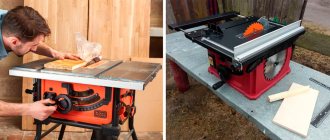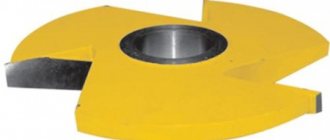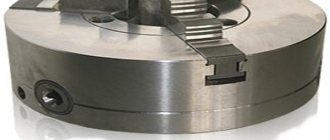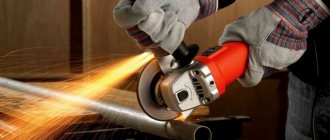Operating principle and device
Slotting machines consist of several key elements. To understand how it works, it is necessary to study the design in more detail. The main nodes include:
- The bed is the base of the equipment on which the remaining structural elements are attached. It can be welded from individual steel elements or be monolithic. The second option is better because it can withstand heavy loads for a long time without deforming.
- A hammer is a working part of a machine that has sharp teeth. Dimensions and shape vary depending on the machine model.
- Work table with clamps for workpieces. On modern models, you can change the position of the table relative to the working part of the slotter.
- Transmission. With its help, the master changes the speed of the cutter to influence the processing of the workpiece.
Industrial models of slotters are equipped with cooling systems. They effectively cool the sharp teeth of the machine, preventing them from being destroyed or deformed during active use. The surface of the workpiece is additionally cooled to avoid its rejection.
Operating principle of the equipment:
- With the help of an electric motor, the working part makes reciprocating movements. Sharp cutters create grooves or indentations in the surface of the workpiece.
- The part is fed under the cutter due to the movement of the work table. It can move automatically or manually.
There are two modes of operation of the slotting equipment:
- Simple mode. Holes and grooves of regular shape are created. All grooves have the same size and shape.
- Hard mode. Hard-to-reach parts of parts are processed. Holes of complex shapes and different sizes are created.
Industrial slotting machine (Photo: Instagram / stanki.simbirstan)
SLOTTING MACHINES
Design and kinematics of slotting machines
The main models of slotting machines and their technical characteristics are given in table. 14.1.
The nature of the movement of units and the design of machine tools.
Slotting machines are the fourth type of layout
units of planing group machines. In slotting machines, the cutter moves back and forth in a vertical plane perpendicular to the table surface. The nature of the movements of slotting machines is the same as that of transverse planing machines, which is why they are sometimes called vertical planing machines.
11a Fig. Figure 14.1 shows a typical design of a slotting machine. On the bed 1
A box-shaped vertical column
12
A cutter (slider)
8 moves along the vertical guides of the column,
in the lower part of which a tool holder 7 is fixed. The workpiece
6
is mounted on the table 5. The table can be subject to circular, longitudinal and transverse movement.
When setting up a slotting machine using a lever 9
set the number of double strokes per minute of the cutter required for a given technological process, and then, using a square of
10,
set the stroke of the cutter so that the slotting cutter processes the entire length of the workpiece and has the required overrun.
Read also: Technology for the production of plastic fillers for aluminum panels
Rotating the flywheel 11
manual movement of the cutter, check the adjustment of the cutter for the specified processing length.
After setting up the machine, you need to check its correctness, after which you can move the cutter to the workpiece until it touches lightly, and then set the cutting depth. Transverse, circular and longitudinal feed is carried out by hand using flywheels 2-4.
After making sure that the machine is set up correctly, at the push-button station 13
press the “Start” button. To stop the main movement engine, use the “Stop” button. The push-button station has buttons for turning on local lighting and quickly moving the table.
Thanks to the vertical layout of the units, the slotting machine occupies a small production area and allows processing internal shaped contours, which is difficult to perform on longitudinal and transverse planing machines.
Technical characteristics of domestically produced slotting machines
Maximum stroke of the cutter, mm
Diameter of the working surface of the table, mm
Cutter speed, m/min
Maximum cutting force, kN
Electric motor power, kW
Specially designed for punch processing
Note.
The cutter speed values marked with an asterisk are expressed in dv/min.
Rice.
14.1. General view of the slotting machine:
I
- bed;
2 —
flywheel for manual table cross feed;
- 3 — flywheel for manual circular feed of the table; 4 —
flywheel for manual longitudinal feed of the table;
5 - table; 6
- workpiece;
7 — tool holder; 8 —
dolbyak (slider); - 9 — lever; 10 —
square for setting the cutter stroke;
II -
flywheel for manual movement of the cutter;
12 -
column;
13 —
push-button station
Slotting machine mod. 7A420 is designed for processing flat and shaped surfaces in single, small- and large-scale production, as well as inclined planes with the shaper frame rotated at an angle of up to 5°. A typical layout of machine components is shown in Fig. 14.1.
The machine has the following technical characteristics: cutter stroke length 20-200 mm; diameter of the working surface of the table 500 mm; maximum table movement, mm: longitudinal - 500; transverse - 400; maximum cutting force 15 kN; frequency of reciprocating movement of the cutter: 40, 64, 102 and 163 dv/min; overall dimensions of the machine 2300x1270x2175 mm; machine weight 2000 kg.
Let's consider the kinematic diagram
machine
Main movement
- the reciprocating movement of the cutter with the cutter is transmitted from the electric motor Ml (Fig. 14.2) through a V-belt drive with pulleys with diameters of 112 and 372 mm, a gearbox (shafts II and III) to the rocker wheel
z = 78
(shaft IV).
For one revolution of the rocker wheel, with the help of a rotating rocker 2, the hammer 1
makes one double stroke.
Feed movement
carried out in one revolution of the rocker wheel, i.e.
per revolution of shaft IV. Through the feed box 78/19 and shaft III with gears 19/39, 20/20 and 18/36, movement is transmitted to shaft IX, where eccentric mechanism 3
allows the pawl to capture from one to 12 teeth of the ratchet wheel
z
= 48 (shaft XI). When the pawl grabs one tooth of the ratchet wheel, the longitudinal and transverse feeds are minimal and equal to 0.1 mm/d.x. From the ratchet wheel, the movement is transmitted through a 32/32 conical reverse mechanism to shaft XII, from which it is transmitted to the machine table.
Rice.
14.2. Kinematic diagram of a slotting machine mod.
7A420: 1 —
dolbyak;
2
— backstage;
3
- eccentric mechanism
Longitudinal feed
further carried out along a kinematic chain: through helical gears 20/20, a cylindrical pair 27/35 and 35/27
on a lead screw XX with a thread pitch P
-
6 mm. The cost of dividing the dial when moving the table longitudinally manually is 0.05 mm.
Cross feed
from shaft XII is carried out along the following kinematic chain: through cylindrical gears 30/44, 44/48, 48/30 to the transverse feed lead screw XIX with a pitch
P =
6 mm; the cost of dividing the dial when moving the table transversely manually is 0.05 mm.
Circular feed
table is carried out from shaft XII along the following kinematic chain: through a 20/20 helical cylindrical pair to shaft XIII, through 27/39 and 39/27 cylindrical gears to shaft XV, then through a 20/20 helical gear, rotation from shaft XVI is transmitted by cylindrical 20/20 gears on shaft XVII.
The last kinematic pair in this chain is a 1:90 worm pair with a module m =
3 mm. The cost of dividing the dial when rotating the table manually is 2′.
Read also: Brass soldering iron tip
Fast movement
The table is powered by an M2 electric motor, the speed of accelerated longitudinal and transverse movement of the table is 1.77 m/min, and during rotation - 5 m/min at the extreme point of the table.
Main nodes
machine (see Fig. 14.1) are typical for slotting machines: a frame consisting of an upper and lower part connected by bolts; a table located on the horizontal guides of the frame, a slide; rocker mechanism; gearbox; feed box and cutter.
The slotter in slotting machines performs the same role as the slider in cross-planing machines, which is why it is often called a slider. The dolbyak (Fig. 14.3) has a body 1
box-shaped, which moves along the guides of frame 2. The cutter can be installed at different heights relative to the table, depending on the height of the workpiece being processed.
To do this, rotate lead screw VI through a 15/20 conical pair (see Fig. 14.2), after which tighten nut 10
with handle
9
(see Fig. 14.3).
At the bottom of the cutter there is a cutting head 6, which rotates at an angle of 90° in both directions; the head is tightened with a cone 7 using a bolt 8.
When chiseling inclined surfaces, you can move the frame 2
at an angle not exceeding 5°, turning nut 5, and then fastening
3.
The hammer
3
is connected to the slide 2 (see Fig. 14.2).
Despite the fact that in most cases chiselling is now being replaced by other technological operations, for certain types of processing it is the most effective. Therefore, abroad, as well as in Russia, slotting machines are manufactured with both mechanical and hydraulic drives. In Germany, the company WALDRICH COBURG
produces slotting machines with a hydraulic drive (Table 14.2), with stepless control of the slotter speed, automatic feed and accelerated table movement.
The hydraulic drive of the main movement of the machine from WALDRICH COBURG
is shown in Fig.
14.4. The speed of the main movement is controlled by a hydraulic drive 1,
from which the fluid enters the hydraulic cylinder
6.
The piston 5 moves in it together with the rod 2, rigidly connected to the cutter
3.
The reversal of the main movement is carried out from the spool, which is affected by a system of levers from adjustable stops.
The cutter is equipped with a special mechanism for automatically retracting the cutter during the reverse stroke to maintain the cleanliness of the machined surface of the workpiece 4.
Rice. 14.3.
Machine tool mod. 7A420:
1 —
frame;
2 -
frame;
3 -
earring;
4 —
emphasis;
5, 10 -
nuts;
6 —
cutting head;
7 - cone; 8 -
bolt;
9 -
handle
Rice. 14.4.
Hydraulic drive of the main movement of a slotting machine from
WALDRICH COBURG
(Germany):
- 1 - hydraulic drive; 2 —
rod;
3 —
dolbyak;
4 -
workpiece; 5 - piston; - 6 - hydraulic cylinder
The feed movement of the table is controlled by a hydraulic cylinder-rack in the same way as in cross-planing machines with a hydraulic drive.
Accelerated movement of the table is usually carried out by an electromechanical drive.
The hydraulic system provides the following elements of the working cycle: reciprocating movement of the cutter; longitudinal, transverse and circular table feeds; starting and stopping the machine at any position of the cutter. The operation of all parts of the hydraulic system is controlled and regulated from the hydraulic control panel. There is a special shut-off valve with a check valve at the level of the upper plane of the table, which balances the cutter, keeping it from falling when the machine stops
WALDRICH COBURG slotting machines
(Germany)
Metal slotting machines are devices designed for processing metal workpieces. Devices of this type are highly specialized machines and are capable of creating elements of various types by removing metal. Metal slotting machines can be purchased at the appropriate store or made by yourself. You can find instructions on how to create a device yourself in this article.
Purpose
Slotting machines have a highly specialized range of capabilities when compared to other equipment for processing metal workpieces. Technological operations that can be carried out using such machines include:
- Manufacturing of grooves and grooves.
- Processing of stamps.
- The working part can be changed in relation to the workpiece. This makes it possible to process the surface at different angles.
- Machining of gears.
Functionality may vary depending on the equipment configuration.
Specifications
The slotting machine has a number of technical characteristics that determine the productivity, accuracy, and functionality of the equipment:
- Ability to process different materials. To work with metal, machines with a more powerful engine and hard teeth are used.
- Type of drive. Powerful models are equipped with a hydraulic system.
- Dimensions of the table for processing parts. The capabilities of the device depend on this indicator.
- Control system. There may be manual or automatic feeding of parts and equipment.
- Weight, dimensions of equipment. Industrial models are much more than compact machines for workshops.
Work tables can be stationary or located on guides for free movement under the equipment.
Disassembling a slotting machine (Photo: Instagram / kubanzheldormash)
Selection of factory devices
Most often, ready-made slotting machines are purchased from the “GD” model range, which is represented on the market in several series. These are rather outdated devices, which, however, have a sufficient range of functionality and are fully suitable for use in home workshops.
For higher quality and faster processing of parts, foreign-made machines are chosen. They allow you to perform a wide range of metal work.
First of all, this concerns the parameters of the workpieces being processed, the power of the tool, its dimensions and functionality, and the permissible angle for tilting. The ability to move the working surfaces and the slotting unit is of great importance.
When choosing devices, always consider their future location. Small machines with medium or low power are suitable for home workshops. This will save space and energy. For production, more powerful analogues with impressive dimensions are purchased. It is also worth considering the skill level of the person who will work with this or that device.
Video: homemade desktop metal slotting machine.
Varieties
If we talk about the types of slotting machines, we can distinguish two groups:
- Models for private workshops, garages. They are small-sized machines that can be installed on a workbench or have a steel base. Operated manually. To do this, the master installs the workpiece and clamps it with clamps. Next, he starts the machine and manually lowers the working part with the equipment to the workpiece.
- Industrial equipment. These are large-sized machines that are used for mass production of parts. The grooving machine is equipped with movable work tables, a powerful engine, and a cooling system.
Recommendations for selection
Before buying metal slotting machines, it is necessary to take into account a number of factors on which the principle of operation in the future will depend:
- Power of the engine installed on the equipment. The more powerful it is, the higher the performance of the machine. However, as power increases, energy consumption increases.
- Dimensions, type of equipment installed on the working part.
- Equipment dimensions.
- Desk dimensions.
- Maximum permissible dimensions of the workpiece. The functionality of the machine depends on this.
- Possibility of adjusting the feed speed of equipment.
- Control system - manual or automatic.
When choosing industrial equipment, it is necessary to take into account the presence of a cooling system. It will protect parts from damage and equipment from deformation.
Slotting machine with automatic control system (Photo: Instagram / instrumentedison)
Wood slotting machines
Personal experience shows that purchasing a universal machine for short grooves is not profitable either for a hobby or for business. And the groove after it is round, but from the point of view of joint strength, the best properties are with a square or rectangular one. Which is quickly obtained only with drilling and grooving equipment. If you really want to, you can get confused and do it yourself, like the author of the following video:
Grooving parts with heavy chain machines and expensive milling machines, which are also sometimes called “slotting” machines, is convenient only in the production of doors and exclusive solid wood furniture. Where the grooves should have smooth edges, they are often long, and sometimes along the end of the shaped part.
Manufacturing
If you don’t want to buy an expensive model at a hardware store, you can make a metal slotting machine with your own hands. A homemade machine will not be able to perform complex technological operations, but it will be enough for a frequent workshop or garage. Manufacturing:
- Study the design drawings. You can find them on the Internet.
- Prepare consumables and tools.
- A steel plate with a thickness of 10 mm or more is suitable for the base. It can easily withstand shock loads during machine operation.
- Using a welding machine, you need to secure a metal stand to the base. Additionally, it is secured with metal corners, which are welded along the edges.
- A guide for moving the electric motor with accessories is installed on the stand. Secure the platform on which the engine will be located. Check its level.
- Install a belt transmission so that the engine speed can be adjusted.
- Route the wires from the engine to the control panel. Hide them so that they cannot be caught during work.
Place clamps for parts on the workbench. Additionally, it can be equipped with guides so that the workpiece can be moved in relation to the equipment. Clean the welding seams with a grinding machine and coat them with an anti-corrosion compound.
Main characteristics
In the following table I have collected the main characteristics of slotting machines.
Table of main characteristics
| Characteristic | Options | A comment |
| Processed material | Wood | Small machines come in tabletop or floor-mounted versions. Weight up to 100 kg with a cabinet is acceptable for both professional carpentry and hobby workshops. |
| Metal | Equipment for professional workshops and industrial workshops. Massive, heavy and expensive, despite the fact that it was mostly used. | |
| Work unit drive type | Mechanical | In a woodworking machine, rotation is transmitted to the drill chuck directly from the motor, which is located above the working unit - the good thing is that it does not require special maintenance, which is beneficial for the hobbyist. For metalworking equipment, a mechanical drive requires the presence of belt-gear transfer case options, which require daily monitoring of belt tension and the condition of the lubrication system - advisable only for professional use. |
| Hydraulic | Hydraulics move the working elements of the most powerful slotting and planing machines, which are operated by specially trained personnel. | |
| Working equipment | Drilling and grooving machine for wood | Drilling and grooving attachment – a set of a drill and a 4-sided chisel. |
| Metal slotting | Cutters of different shapes, sizes and configurations. | |
| Maximum dimensions of the processed workpiece, mm | 120-160 | Drilling and grooving machines. In the basic position – no more than 120; with branded rack extensions - up to 160. If you turn the rack in the opposite direction from the desktop, then the dimensions are limited only by the distance to the floor. |
| 500-700 | Metal machines. For serially produced vertical ones – up to 500. For planing ones – up to 700. | |
| Method for adjusting the supply of equipment | Manually | For working with wood. The design is equipped with a long lever, which allows you to plunge the square chisel into the hole being drilled without excessive force. The processing depth is controlled locally by the operator or limited by various stops. |
| Automatically | The frequency and depth of cutter stroke are set by the machine settings. Used on metalworking machines. | |
| Weight | Up to 100 | Woodworking desktop and stationary machines, the installation of which requires only a flat surface of the floor or workbench. |
| Over 250 | Metalworking equipment. It is fixed rigidly; for models weighing a ton or more, their own foundation is required. If high-precision machines (class B, A, C, T, K) are located nearby, then vibration isolation is necessary. |
On drilling and grooving machines, setting the position of the workpiece is done manually, in two different ways. Some models have a movable table on which the workpiece is mounted - the table with the part is adjusted in space with millimeter precision. And for others, you have to move the workpiece on a stationary table. For metal slotters, the part is fixed in a lathe chuck; the position is adjusted manually with an accuracy of hundredths of a millimeter.
In this article I will consider two of the most popular models - metal and wood.
Didn't find the machine you're interested in? Write to me, perhaps I am familiar with this equipment. Model summary table
| Model | Peculiarity | Average price, rub. |
| Woodworking | ||
| 1. Encore Corvette 91 | A good machine with decent functionality and high precision. Equipped with a set of 5 cutters with drills. But all the positive impressions are spoiled by the constant need to adjust it. For a hobbyist, the potential is huge; for continuous production, the machine needs to be modified and high-quality chisels and drills must be selected. | 23 000 |
| 2. Jet jbm5 | Professional equipment. Every detail is in its place, nothing superfluous. Minimum settings, maximum ease of use. It may seem that if there is no equipment, the machine is expensive, but there are fewer problems with it than with inexpensive models. | 28 000 |
| Metalworking | ||
| 3. 7D36 | Reliable and powerful industrial machine for gouging and trimming horizontal surfaces. In the basic configuration, this equipment is not fully capable of replacing a vertical slotter, but by purchasing a universal dividing head for it, you can make internal splines and gears. | 100 000 |
| 4. 7a420 | Repairable, easy to operate and maintain. But taking into account all its capabilities - internal splines, grooves, gears, including conical and complex shapes - its place is not in production line production, but in the repair shop. | 200 000 |
Exploitation
Before you start working with a slotting machine, you need to familiarize yourself with the tips for its operation:
- Use safety glasses while working. They will protect your eyes from flying metal particles when materials hit each other.
- Clean the work surface after work.
- Lubricate moving parts with motor oil to make them last longer.
- Check that the parts are securely fastened in the clamps before starting work.
- Before starting, check the integrity of the equipment. The teeth must be sharpened. The presence of chips and cracks should alert you. Such equipment cannot be used for chiselling.
- It is important to consider the hardness of the teeth and the workpiece. If the workpiece is stronger, the equipment will break upon impact.
You cannot try to process high-strength alloys using a homemade machine or make grooves of complex shapes. This requires professional equipment.
A slotting machine is a machine that can be used to make holes of different shapes in metal parts. The equipment, under the influence of the engine, makes grooves with impacts. The harder the working teeth, the more materials can be processed.
Watch a video about a vertical slotting machine:
